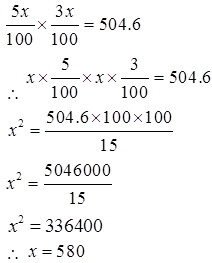Arithmetic - Online Test
Q1. Radhika has two daughters by name Rinku and Sindhu.The ratio of the age of Radhika and Rinku is 3:1 and that of Rinku and Sindhu is 8:5.Given that Rinku is six years elder to Sindhu.Find the ratio of their ages after 12 years.
Answer : Option D
Explaination / Solution:
The ratio of the ages of Radhika and Rinku is 3:1.
Let their ages be 3x and x respectively –(1).
The ratio of ages of Rinku and Sindhu is 8:5.
Let their ages be 8y and 5y.
Given that Rinku is 6 years elder to Sindhu. 8y - 5y = 6 ⇒ y = 2.
Thus,the present ages of Rinku and Sindhu are 8 × 2 = 16 and 5 × 2 = 10 respectively.—(2)
From (1) and (2),we have x = 16.
Therefore,the age of Radhika is 3 × 16 = 48.
After 12 years,their ages would be 48 + 12 = 60,16 + 12 = 28 and 10 + 12 = 22 respectively.
So,the ratio is 60 : 28 : 22 or 30 : 14 : 11 (dividing throughout by 2).
Q2. Ganesh and Venkat work for the same company. Initially, their salaries were in the ratio 3:2. Later, Venkat’s salary was increased by some amount which has changed the ratio into 30:31.Find the hike in pay for Venkat given that his initial salary was Rs.20,000.
Answer : Option B
Explaination / Solution:
Let the initial salaries of Ganesh and Venkat be 3x and 2x reapectively.
Given that, 2x = 20000 ⇒ x = 10,000.
Let w be the hike in pay for Venkat.Therefore,the salary of Venkat is now 2x+w while Ganesh’s salary remains to be 3x.The new ratio is 30:31
Hence the proportion here is 3x : 2x+w :: 30 : 31
Using laws of proportion,we have (2x+w)30 = 31× 3x
⇒60x + 30w = 93x
⇒30w = 33x
⇒w = 1.1x
⇒w = 11000 (since x=10,000)
Q3. On children’s day sweet were to be equally distributed amongst 300 children. But on that particular day 50 children remained absent; hence each child got one sweet extra. How many sweets were distributed?
Answer : Option C
Explaination / Solution:
Let the number of sweets be x


=>x = 30 × 50 = 1500
Q4. The product of 5% of a positive number and 3% of the same number is 504.6. What is half of that number?
Answer : Option A
Explaination / Solution:
Let the positive number be x


x/2 =290
Q5. The average of four consecutive even numbers P, Q, R and S respectively (in increasing order) is 51. What is the product of P and R?
Answer : Option E
Explaination / Solution:
P, Q, R and S are four consecutive even numbers.
Hence
Q = P+2,
R = Q+2 = P+4,
S = R+2 = P+6
Hence their sum = P+Q+R+S = 4P+12
Average
= (P+Q+R+S)/4
= (4P+12)/4
= P+3 = 51
→ P = 48
R = P+4 = 48+4 = 52
Hence P×R = 48 ×52 = 2496
Q6. The profit earned by selling a Radio for Rs. 824 is 16% more than the loss incurred by selling the same for Rs. 500. At what price should the Radio be sold to earn profit of 12%?
Answer : Option C
Explaination / Solution:
Let the cost price of the Radio = Rs. x
Now according to the question we can write,
(824 – x) = (x – 500) × (116/100)
⇒ 824 – x = (x – 500) × (29/25)
⇒ 25 × (824 – x) = 29x – 14500
⇒ 25x + 29x = 20600 + 14500
⇒ 54x = 35100
⇒ x = 650
So, the cost price of the Radio = Rs. 650
∴ The required selling price to earn 12% profit = Rs. 650 × (112/100) = Rs. 728.
Q7. In my village, the age of all female is 21 years and all male is 32 years, where the average age of all the male and female of the village is 28 years. Total number of villagers in my village is how much?
Answer : Option B
Explaination / Solution:
By using allegation


Since the ratio of female and male is 4:7, so the total number of villagers must be the multiples of 11.
Hence the possible answer is 231.
Q8. A group of girls contributed eight times as many rupees each for their trip as they were in the number. The total collection came to Rs 6272. How many girls were there in the group?
Answer : Option A
Explaination / Solution:
Let number of girls be x. Each contributed = 8x
Total contribution = 8x2= 6272 ⇒ x2 = 784 ⇒ x = 28
Q9. A train left from station A for station B at 4 pm at an average speed of 80 kmph. At 8 pm, another train also had left from station A for station B on a parallel track at an average speed of 120 kmph. How far from A is another train expected to overtake the first train?
Answer : Option C
Explaination / Solution:
Distance covered by 1st train in 4 hours = 80*4 = 320 km
Relative speed of 2nd train = 120-80 = 40 km
It will overtake another train in 320/40 = 8 hours
Distance between overtake point and station A = 8*120 = 960 km
Q10. The simple interest accrued on a sum of certain principal is Rs. 7200 in 6 years at the rate of 12 per cent per year. What would be the compound interest accrued on that principal at the rate of 8 per cent per year in 2 years?
Answer : Option D
Explaination / Solution:
One year interest = 7200/6 = 1200
R = 10% so principle amount is 10000
For same principle 2 year compound interest is {(8+8.64)*10000/} 100 = 1664
